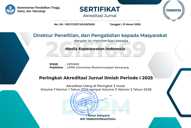Hospital Shift Hours and Its Effect on Quality of Life among Nurses: A Comparative Study
(1) Fakultas Psikologi Universitas Padjajaran
(2) Fakultas Psikologi Universitas Padjajaran
(3) Fakultas Psikologi Universitas Padjajaran
(4) Fakultas Psikologi Universitas Padjajaran
(*) Corresponding Author
Abstract
Keywords
Full Text:
PDFReferences
Kabeel A, Eisa S. Relationship between job satisfaction and professional identity among psychiatric nurses. Egypt Nurs J 2017;14:9. https://doi.org/10.4103/2090-6021.206939.
Gerber L. Understanding the nurse’s role as a patient advocate. Nursing2021 2018;48.
Kemenkes R. Infodatin Perawat 2017.Pdf 2017:1–12.
Sun Q, Ji X, Zhou W, Liu J. Sleep problems in shift nurses: A brief review and recommendations at both individual and institutional levels. J Nurs Manag 2019;27:10–8. https://doi.org/10.1111/jonm.12656.
Books C, Coody LC, Kauffman R, Abraham S. Night Shift Work and Its Health Effects on Nurses. Health Care Manag (Frederick) 2020;39.
Vitale SA, Varrone-Ganesh J, Vu M. Nurses working the night shift: Impact on home, family and social life. J Nurs Educ Pract 2015;5. https://doi.org/10.5430/jnep.v5n10p70.
Dai C, Qiu H, Huang Q, Hu P, Hong X, Tu J, et al. The effect of night shift on sleep quality and depressive symptoms among Chinese nurses. Neuropsychiatr Dis Treat 2019;15:435–40. https://doi.org/10.2147/NDT.S190689.
Ibrahim Al Ameri MH. Night Shift and its Impact upon the Quality of Life of Nurses Working at the Teaching Hospitals of the Medical City Complex in Baghdad City, Iraq. J Nurs Care 2017;06:6–10. https://doi.org/10.4172/2167-1168.1000414.
The WHOQOL GROUP. Development of the World Health Organization WHOQOL-BREF quality of life assessment. Psychol Med 1998;28:551–8. https://doi.org/10.1017/s0033291798006667.
Delmas P, O’Reilly L, Cara C, Brousseau S, Weidmann J, Roulet-Schwab D, et al. Effects on nurses’ quality of working life and on patients’ quality of life of an educational intervention to strengthen humanistic practice among hemodialysis nurses in Switzerland: A protocol for a mixed-methods cluster randomized controlled trial. BMC Nurs 2018;17:1–11. https://doi.org/10.1186/s12912-018-0320-0.
Ersanti ER, Ny V, Bulan R, Sitanggang YF, Hutasoit EO, Keperawatan MF, et al. Gambaran kualitas hidup profesional pada perawat di satu rumah sakit swasta indonesia bagian barat. Nurs Curr 2018;6:29–37.
Ch Salim O, Sudharma NI, Kusumaratna RK, Hidayat A. Validity and reliability of World Health Organization Quality of Life-BREF to assess the quality of life in the elderly 2007;26:27–38.
Purba FD, Hunfeld JAM, Iskandarsyah A, Fitriana S, Sadarjoen SS, Passchier J, et al. Quality of life of the Indonesian general population : Test-retest reliability and population norms of the EQ-5D-5L and 2018:1–20.
WHO. WHOQOL User Manual. L 2012:1–19.
Heckman CJ, Kloss JD, Feskanich D, Culnan E, Schernhammer ES. Associations among rotating night shift work, sleep and skin cancer in Nurses' Health Study II participants. Occup Environ Med 2017;74:169 LP – 175. https://doi.org/10.1136/oemed-2016-103783.
Safitrie A, Ardani MH. Studi Komparatif Kualitas Tidur Perawat Shift dan Non Shift di Unit Rawat Inap dan Unit Rawat Jalan. Pros Konf Nas PPNI Jawa Teng 2013:17–23.
Rogers SN, Travers A, Lowe D, Levy AR, Midgely AW. Importance of activity and recreation for the quality of life of patients treated for cancer of the head and neck. Br J Oral Maxillofac Surg 2019;57:125–34. https://doi.org/10.1016/j.bjoms.2018.10.001.
Mafini C, Dlodlo N. The relationship between extrinsic motivation, job satisfaction and life satisfaction amongst employees in a public organisation. SA J Ind Psychol 2014;40:1–13. https://doi.org/10.4102/sajip.v40i1.1166.
Liu H, Zhang X, Chang R, Wang W. A research regarding the relationship among intensive care nurses’ self-esteem, job satisfaction and subjective well-being. Int J Nurs Sci 2017;4:291–5. https://doi.org/10.1016/j.ijnss.2017.06.008.
Sabanciogullari S, Dogan S. Professional self-concept in nurses and related factors: A sample from turkey. Int J Caring Serv 2017;10:1676–84.
Peleias M, Tempski P, Paro HBMS, Perotta B, Mayer FB, Enns SC, et al. Leisure time physical activity and quality of life in medical students: results from a multicentre study. BMJ Open Sport &Amp; Exerc Med 2017;3:e000213. https://doi.org/10.1136/bmjsem-2016-000213.
Article Metrics
Abstract view : 809 timesPDF - 26 times
DOI: https://doi.org/10.26714/mki.4.2.2021.92-100
Refbacks
- There are currently no refbacks.
Copyright (c) 2021 Andina Prameswari, Ligina Ayudia, Halimah Sya'diyah, Aulia Iskandarsyah

This work is licensed under a Creative Commons Attribution 4.0 International License.
This journal is indexed by:
Kedungmundu Raya No. 18 Semarang NRC Building Universitas Muhammadiyah Semarang
Phone: 02476740287
Fax: 02476740287
Email: [email protected]





















